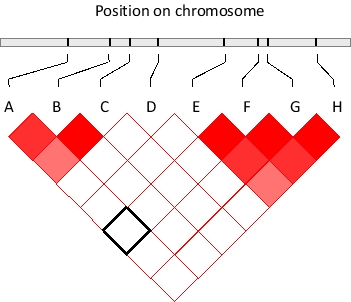If two genomic polymorphic sites were randomly and independently associated with each other, one would expect the frequency of observing a combination of their allelic forms in an individual to be equal to the multiplication product of the probability of the alleles occurring separately. In many cases, however, this is not true. The degree of deviation from random association can be quantified and summarized in diagrams such as the one below. In this diagram, eight SNPs in a genomic region are shown and their pairwise deviation from random association is color-coded by different shades of red, such that the darkest red shade indicates the furthest deviation from random association. In contrast, those pairs that associate randomly are colored white. For example, SNPs A and F seem to associate randomly as indicated by the corresponding box marked with black borders. From this diagram, two haplotype blocks can be readily detected. What subset of the shown SNPs is not part of any of the two blocks? Write down the letter(s) as your answer, in alphabetical order, e.g. CEH. 
Definitions:
Intelligence
The capacity for learning, understanding, problem-solving, and adapting to new situations using various cognitive processes.
Unrepresentative Sample
A sample that does not accurately reflect the characteristics of the larger population from which it is drawn, potentially leading to biased results.
Correlation Coefficient
A statistical measure that indicates the extent to which two variables fluctuate together.
Scatterplot
A graph in which the values of two variables are plotted along two axes, the pattern of the resulting points revealing any correlation present.
Q3: Which of the following is true regarding
Q9: What determines the time and place that
Q9: Mutant Saccharomyces cerevisiae cells that lack the
Q18: In the following schematic drawing, two DNA
Q25: How is membrane protrusion by blebbing different
Q37: You are viewing a sample of pond
Q48: If two genomic polymorphic sites were randomly
Q48: When unfolded proteins accumulate in the lumen
Q53: Which of the following is an actin
Q55: Indicate whether each of the following descriptions